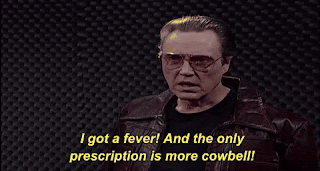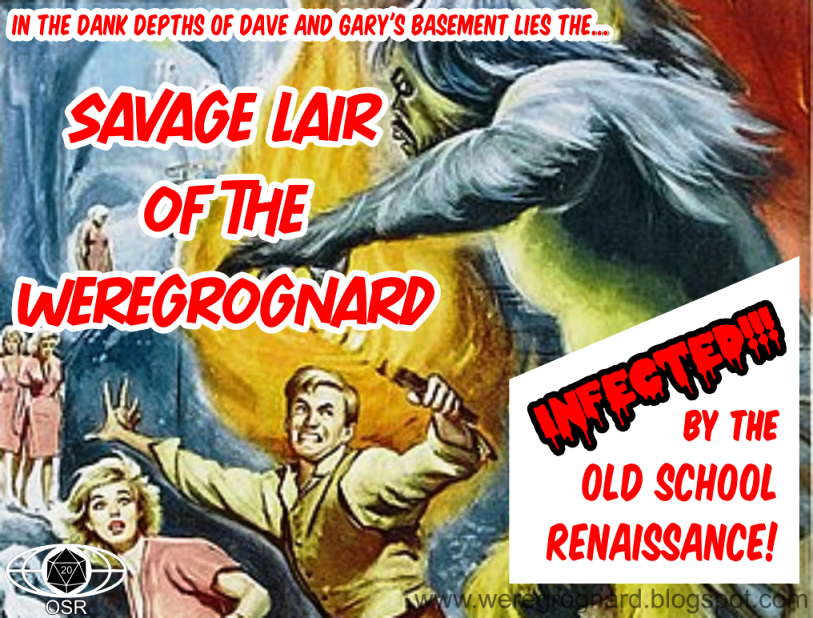I’ve been two sword hilts deep into the video game Witcher 3, thanks first, to the Netflix series, and now the books, which I received last Christmas. Needless to say...
 |
| Also, more Witcher! |
It’s got me thinking about D&D and the swords and sorcery genre. There are more than a few fans of D&D who feel the game doesn’t do the genre of swords and sorcery very well. Personally, I think this is poppycock, balderdash, and even nonsense.
 |
| Nonsense, I say! |
Arguably, the material that inspired the game, from Arneson’s to Gygax’s “Appendix N” is 99.99% swords and sorcery. Later, the setting that the venerable, Orignal and AD&D books imply puts this clearly into practice: humanocentric societies, Vancian-inspired magic, dangerous wilderness, and seedy cities (like Greyhawk) that are essentially love letters to Lankhmar.
But before y’all get your neckbeards in a fluff, you nay-sayers have a point. The “G” part of RPG, the “crunch”, if you will, sometimes kills the sword and sorcery vibe with things like Tolkienesque races and creatures, dazzling, super-powered spells and magic items, including the restorative powers of clerics and paladins. Even the nine-point alignment system tends to make things less morally ambiguous, and harder to depict a grimdark world.
Now, GMs can always remove certain races, spells, etc. from the game to fit their vision of swords and sorcery, and this is fine*, but what if you didn’t have to? What if you could have your cake and eat it too, enjoying your grimdark world of heavy metal slaughter, dark magic, and low stakes, while pleasing your players who always insist on playing pseudo-Scottish dwarves and pretty, ethereal elves? The setting of the the Witcher series serves as an example. With just a few things to keep in mind when creating your milieu, the ”RP” part of RPG, or “fluff”, you can do just that.
* and commercially successful.
1. The world is a crapsack place and people are horrible (just like in ours!)
The world of The Witcher, while fantastic, is firmly grounded in a time similar to the Late Medieval period (14-15th centuries.) A quick look at Lazypedia tells us that it wasn’t exactly a great time to be alive. The Four Horsemen of the Apocalypse (The Wild Hunt?) are trampling through Europe with wild abandon: Famine due to a miniature Ice Age, Pestilence in the form of the Black Plague, and the Hundred Years’ War, all contributing to massive Death. A terrible time and place to be in, but wonderful for gaming!
 |
| Whee!!! |
The world of The Witcher is similarly war-torn and wracked by conflict, showing its grim side effects: ravaged countrysides, banditry, famine, disease, and human desperation. A common theme the Witcher series is that humans are often worse than monsters. Characters in the stories and games tend to have dark backgrounds or secrets:
· A vampire-like monster that plagues the local ruler’s lands is the cursed issue of an incestuous relationship with his sister.
· An undead creature was the result of a miscarriage caused by an abusive, wife-beating husband.
· The friendly, local hedge wizard/wise man/pet goat enjoyer is a guilt-ridden patricide.
In your D&D Campaign: Play up the fact that the world is dangerous. This is not difficult, especially in low-level, old school D&D. The fact that the game has wargaming roots and the players can, with experience and gold, become warlords with strongholds and small armies implies a war-torn world with little or no central authority. There is a modicum of law, order, and safety to be found in the 50-mile, patrolled area around a local ruler’s castle, but none past that. This is supported perfectly by the harsh difficulty of D&D’s wilderness encounter tables. A typical point-of-light in the wilderness can be easily snuffed out by a humanoid or monster invasion, or even hostile neighbors. There should be evidence of this in ruined castles and destroyed villages (some the lairs of monsters and bandits) in your wilderness. Even within the safety of patrolled areas, the men that wear the local ruler's colors are little more than legitimized thugs and bandits themselves.
Major NPCs you come up with should have a dark secret or a terrible story, preferably tied to an adventure hook or location. Just pick one of the Seven Deadly Sins (pride, greed, wrath, envy, lust, gluttony and sloth,) and roll with that. Even with alignments, all characters can have deep moral flaws, and even the best are fallible. You can use the Law/Chaos axis only, or downplay the Good/Evil axis for average people. For example, the local farmer might try to be Lawful and Good (and he is 80% of the time,) but there was that one time where he couldn’t help sleeping with his friend’s wife, and then left his friend in the woods to die when said friend suffered a hunting accident, knowing that he could then have his way with the wife at any time. Coincidentally, the friend’s corpse has attracted an entire ghoul lair to the area, or maybe he rose as vengeful undead (or both!)
 |
| I killed my parents with a rusty axe because I was hangry (AI image courtesy of NightCafe.) |
2. Non-humans are a (feared and hated) minority
Much like in the implied D&D setting, the world of The Witcher features non-human civilizations whose day in the sun has long since passed. The elves, dwarves, halflings, and gnomes are considered second-class citizens in most places, regularly oppressed, and often the victims of terrible, genocidal pogroms. Some, like the elven freedom fighter/terrorist scoia'tael, are equally terrible towards humans in return, and they might say justifiably so.
In your D&D campaign: Humans and demihumans typically don’t exist in the same communities, and tend to be segregated when they do (either voluntarily or by local law.) Most rural humans have never met an elf or a dwarf and just know them from tales and local superstition. Even if all the player characters are non-human, they will be met with equal parts curiosity and suspicion when in (human-dominated) towns and villages. Similarly, elf, dwarf, and halfling communities can be highly xenophobic themselves.
If you would rather not deal with the subject of racial prejudice in your game (even in a fictional context,) you can at least make NPC non-humans rare, and give them some strange or negative qualities, quirks, and cultural norms like in the darkest of fairy tales. Maybe elves are decadent hedonists whose diversions with others amount to cruel (and sometimes deadly) pranks; there is no word for “consent” in the elven language. Maybe dwarves are just as greedy as in the stories, and tend to waylay those openly displaying gold. You see, it’s an involuntary impulse where they fly into a frenzy at the sight (or maybe smell) of it. Have you ever wondered why halfling villages are so peaceful and prosperous in the middle of the dangerous wilds? What manner of beings must they sacrifice to in order to have those bountiful harvests every year?
 |
| Y'ndalla ftaghn! (AI image courtesy of NightCafe.) |
3. Exceptional people are rare (and also hated)
As a mutant with extraordinary abilities, the titular character in The Witcher (Geralt of Rivia) is, to the average person he meets, not much different than the monsters he hunts. He faces hatred and disgust wherever he goes as a general rule, except for when the people need him to take care of a (monster) problem. Even the beautiful sorceresses don’t fare much better. They might be welcome in high society, as the powerful have need of them, but they are not loved (mostly because they manipulate and meddle in the world's politics.)
Generally speaking, people tend to at best fear (or be in awe) of what they don’t understand, and at worst, excoriate those too dissimilar to them or their community, especially in a pseudo-medieval world. It’s all too easy to dehumanize those who stand out and the desire to bring them down when they are at their weakest is a strong human impulse (just look at cancel culture today!)
In your D&D campaign: Considered player characters, and classed NPCs as the “one percent.” The vast majority of the NPCs in the world fall in the “normal human” category, and they know it, deep down and painfully. They’ll never have the powers, magic, or gold pieces that adventurers have. It turns out might *does* make right! Why is that guy over there the local lord? Because he’s a freaking 9th-level fighter, that’s why! You think a 1st-level magic-user is a big nothing with their one, measly spell? Consider what one can potentially do once every day:
· Charm anyone into a friend (or perhaps lover) – you know how far you could get in the real world with this power alone?
· Cart away a prize sow, year’s harvest, or town treasury quietly in the night with a floating disc of magical force
· Strike a regular person dead, or seriously injure them with an unerring, magical missile
· Put an angry peasant mob to sleep
· Cast a magic shield to fend off said mob’s ire (and pitchforks)
When adventurers come into town, they should be treated with fear and suspicion as the powerful murder-hobos they are. The local ruler will be will be very interested in tracking their every move (since they are a threat to his power,) and his rivals might consider what part the adventurers can play in advancing their own goals. The neighborhood good ol’ boys may give a player character fighter a wide berth, but they might gang up on him later just to see if they can take down the fastest sword in the West, especially if they have bellies (and brains) full of liquid courage. A magic-user could have peasants coming to her for hexes and other magical solutions, only to want to burn her at the stake later (to avoid payment.) Even the cleric may be openly welcomed by the local vicar while being secretly (and jealously) hated for his saintly powers: “What makes him so special? Maybe those powers came from an evil, ungodly source! I should write to the inquisitors just in case!” Of course, thieves are never welcome anywhere, and rival thieves least of all.
“True” magic spells and items are strictly the purview of only these rare
one-percenters. Your average NPC doesn’t
know anything about magic, and has likely never seen a spell, let alone a magic
sword or ring, but has plenty of beliefs, superstitions, and erroneous, common knowledge
regarding these. There should be a
plethora of NPC fortune-tellers, soothsayers, hedge-wizards, cunning women, and
other grifters and con-men with little to no real power, who are all too ready
to prey on these beliefs with expensive charms, talismans, and B.S. “cures” for
colic, bunions, rheumatism, broken hearts, and the like. Even if there is a local cleric that can cure
wounds and raise the dead, these limited miracles likely reserved for the
ruling family and nobility, hence the high price in gold for these services. One or two spells for curing disease per day cannot possibly hope to stave off a plague spreading like wildfire through a population (especially one that has no knowledge of germ theory and sanitary practices.)
And there it is! By following the example of the Witcher series, it is easy to include all aspects of D&D, while still having a pretty dark, low(ish) magic campaign in the vein of sword and sorcery stories. So “toss a coin to your witcher” (or adventures) next time they come to town. I’m off to win a high-stakes Gwent tournament!
 |
| Do I use the Scorch card this round or save it for the next? |




No comments:
Post a Comment